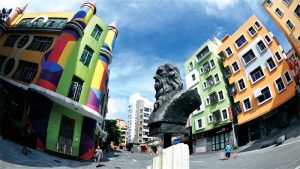At a time where villages in China are either being torn down or abandoned, the Dafen Art Village thrives. It has become one of China’s most successful and sustainable villages, inspiring many others to try and duplicate their success. It has also become a popular tourist attraction, generating a lot of money for the Chinese economy. The reason for its unique success is because of its unique form of urbanization and transformation of identity. The Dafen Village has used art as its medium to transform the villages identity in multiple ways and urbanize without physically destroying and reconstructing the village into skyscrapers.
Through new artworks, the village has transformed its former identity as a solely reduplicative artistic village to an original, creative art village. The village was once known for only reproducing famous artworks from artists like Picasso or Davinci (Dafen comes from the artist name Davinci). However, now its identity has transformed from being a village where you could only purchase recreated artwork to a village where you can get unique, beautiful and original artwork. This transformation is highlighted by the new art museum and artist residencies in the village. The museum has become a symbol of the villages new identity by featuring mostly local artists original work, with very few reduplications. The museum highlights this newly formed artistic identity of the village, through displaying the unique and talented artists work for tourists and locals to see Dafens contribution to the art world. Furthermore, this transition can be seen by the new artist residency the Village has created. Now, artists are being encouraged to come live and study art in the village, whereas in the past they were only being encouraged to come reduplicate art. The village and Government officials have identified this newfound identity of the village and have embraced it in order urbanize the village and make it sustainable.
 The Village has also transformed its identity from a local producer to a global producer of art work. This is highlighted through the villages Main Street, where the artworks are sold. All throughout the street there are many shops and artist selling thousands of pieces of art. In the past many local Chinese and Chinese business vendors would come to Dafen to buy these works. However, now thousands of tourists and businesses from various parts of the globe flock to Dafen to buy the artwork. They still sell reduplicated works, but the main focus now is on original artwork produced by the young local villagers. This gives the villagers and the village a new incentive to embrace art as a medium to expose their talent and identity worldwide. This generates a lot of money for the village and the Chinese government, thus making the village sustainable.
The Village has also transformed its identity from a local producer to a global producer of art work. This is highlighted through the villages Main Street, where the artworks are sold. All throughout the street there are many shops and artist selling thousands of pieces of art. In the past many local Chinese and Chinese business vendors would come to Dafen to buy these works. However, now thousands of tourists and businesses from various parts of the globe flock to Dafen to buy the artwork. They still sell reduplicated works, but the main focus now is on original artwork produced by the young local villagers. This gives the villagers and the village a new incentive to embrace art as a medium to expose their talent and identity worldwide. This generates a lot of money for the village and the Chinese government, thus making the village sustainable.
The village has also modernized its architecture and identity through art rather than construction. Various buildings throughout the village are covered in murals and artwork. They also are painted bright, modern colors and have sculptures outside or pieces of art hanging from them. These buildings are a physical symbol of the ideological shift in the villages identities. The artistic buildings are representative of the villages shift from a once reduplicative art village to an original, unique art village. They also are a representation of the shift from the local to global because now these buildings are being used to house international art students in the Dafen Village. 
The Dafen Art village has used art as its medium to transform their identities and modernize without destruction. Dafen is a symbol of success to other villages and is one of the most sustainable villages in China. It is a symbol of how villages can use identity and other forms of urbanization besides skyscrapers to modernize and thrive. For Dafen the medium in which they used to urbanize and transformed their identity was art.
